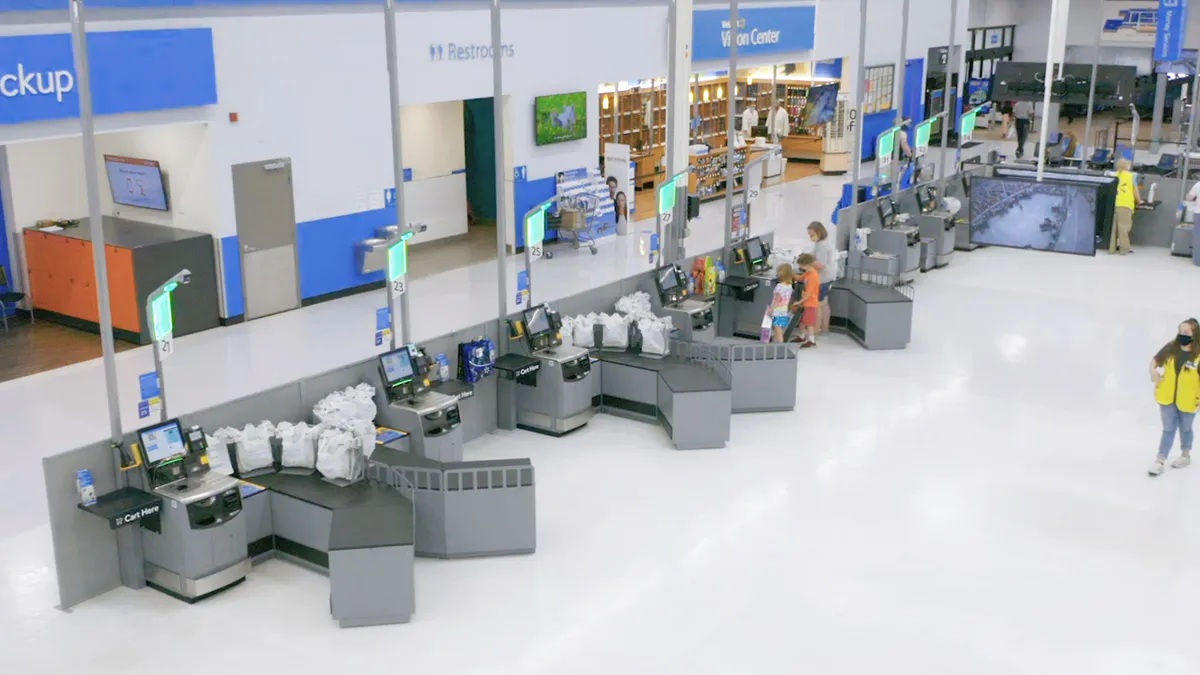Dive Brief:
- Walmart is conducting an experiment at a supercenter in Fayetteville, Arkansas, to find out if swapping traditional checkout lanes for a cluster of self-checkout stations staffed by a team of roaming associates can help it serve customers more effectively, according to a post on the retailer’s website.
- Walmart has installed 34 customer-operated checkout stations in an open area at the front of the 180,000-square-foot store. The new stations entirely replaced the store's former checkout lanes. All of the store’s cashiers have been reassigned to more flexible “host” roles, which allow them to move around and assist customers with aspects of their orders beyond ringing up items.
- Associates in the new checkout area direct customers to available registers, help them operate the checkout equipment and can scan and bag items upon request. “By nature, individual lanes make the checkout experience transactional, but being face-to-face, the interaction becomes a relationship. We want to make it a personal experience,” John Crecelius, senior vice president of Walmart U.S. innovations development, said in the post.
Dive Insight:
Walmart’s experiment, which went into action in June, is a twist on the idea that automation reduces interaction between people — and saves money — by cutting down on the need for human labor. The retailer is instead seeking to use self-checkout technology to free staff members to turn the often-impersonal experience of shopping at a large mass-market retail store into a more engaging one.
Eliminating checkout lanes in favor of an open, staffed area ringed with self-checkout stations promises a host of benefits, including speeding up the checkout process by allowing the store to have a large number of registers in service without needing to deploy an associate to each one. In addition, customers no longer face the frustrating experience of trying to guess which lane will move fastest when they arrive in the checkout area.
The new approach might also help Walmart save money. It takes less than a day to prepare workers to serve in the new role the retailer created to help people navigate the self-service-oriented checkout stations in its Fayetteville store, the retailer said. By comparison, teaching someone how to operate a traditional cash register, a more complicated job, takes an average of 40 hours, Walmart noted.
Another potential upside of the new concept is that associates are likely to have more opportunities to practice social distancing when moving between checkout stations than if they are confined to a single cash register. Customers also stand to benefit if they don’t have to be close to a store employee when checking out.
Walmart is likely to face challenges if it looks to expand the experiment beyond Fayetteville, which enjoys the advantage for Walmart executives of being within easy reach of the retailer’s headquarters in nearby Bentonville, Arkansas, said Chris Walton, a retail expert who is co-CEO of OmniTalk and formerly served as a Target vice president.
“The hardest part for legacy retailers is there’s a lot of debt that you carry in terms of the generational expectations of your customer base, so I don’t think it’s going to spread like wildfire,” Walton told Grocery Dive.
But while it could take time for the idea of trading a store’s checkout lanes for a combination of self-checkout technology and a team of floating hosts, Walmart’s willingness to try the concept is an audacious move, Walton said, especially given the retailer’s enormous scale and the breadth of items one of its supercenters carries.
Walmart had global sales of $524 billion in its most recent fiscal year and serves 265 million shoppers per week at 11,500 stores around the world, according to the company. The retailer employs 2.2 million people and is the world's biggest retailer as measured by revenue, according to Forbes.
“To have the guts to say, ‘We know this could be cognitively dissonant, and we’re going to try it because at the end of the day we think it could be better, that’s a bold move,” Walton said. “You don’t see retailers make that kind of move very often.”
Walton compared Walmart’s experiment with a new checkout process to the way airlines have changed the way passengers check in for a flight. “This isn’t new. It’s just hitting this industry at a different time,” he said. “Airlines had kiosks and people stood in lines, and it took a while for people to gravitate towards [self-check-in] stations … now you’re lucky if any one even wants to go to an agent."













